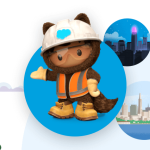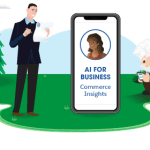The digital-first future is no longer a buzzword or a hypothesis: it’s reality. And with customers doing more and more of their business online — through choice as well as circumstance — it’s easy to see why.
But there’s a big difference between talking the talk and actually walking the walk. To have real visibility over your operations and a complete, joined-up view of the customer, businesses need sophisticated data analytics they can trust. That’s rarer than most realise.
So for our first ever fully online Salesforce Live: EMEA event, we spoke to Henkel, Mars and El Al, three global organisations blazing the trail in data and analytics to see how they’re leading the way in the digital-first future.
How Henkel is using data analytics to evolve
Henkel is a chemical and consumer goods company with 144 years of success behind them, recognised by the World Economic Forum as an Industry 4.0 leader. Wolfgang Weber, Henkel’s Head of International Engineering and Digital Transformation, explained why, during COVID-19, real-time data accessibility has become even more critical.
At Henkel, operational statuses, sustainability, quality checks, and health statuses are all available immediately through massive sensors on their manufacturing lines.
“Through our platforms, we are still able to remotely control what’s going on, to manage the volatility that we see across our categories and portfolio in the market, and to steer all the availability of operations to serve our clients. I’m proud to say we managed with almost zero interruptions through the entire process.”
Henkel used to have a more descriptive, reactive approach to data. But since adopting Tableau and leveraging the platform’s visualisation and analytics capabilities, they’ve built a 360-degree view of their customers and operations and have moved to a more predictive approach.
“We built up a scalable ecosystem connecting all our factories around the globe in real time,” Weber explains.
Henkel blends raw transactional data from its ERP system with operational data from its plants, running specific analytics according to its production planning system. And it’s only just getting started too, with a rich pipeline of further applications that will eventually be plugged into the system.
In fact, it’s even installed digital SPOCs [single points of contact] in each and every facility and production cluster as well, so as not to lose visibility over what’s happening on the ground.
“We connect with the factories and the shop floors on a regular basis to ensure this approach cascades through the entire organisation, and vice versa: not top-down or bottom-up, it’s bi-directional. Data flowing freely is a huge part of Industry 4.0.”
Rethinking the rules of data integration and BI analytics at Mars
Mars, Incorporated is not just a consumer goods giant that produces delicious treats, food and Petcare products. They’re also at the cutting edge when it comes to employing new technologies whilst also investing in Associates. Amitabh Apte, Global Director of Digital Data and Analytics told us that data integration is an integral part of the future at Mars.
“We’re embracing digital now faster than ever before, building capabilities that enable faster, more relevant consumer and business insights that drive value. We’re trying to reach customers across every touchpoint and to do that we have to re-assess the traditional rules of data integration and BI analytics.”
“That means real-time data analysis and democratised, on-demand access to it. It means proactively creating data assets with actionable insight before a team even knows they need it.
“The next-gen organisations are the ones doing that: not reacting and responding but building strong momentum for data & analytics usage to think proactively about how data as an asset will help us make the best decisions in the future.”
“For Mars, we continue to evolve new ways of working and thinking, such as User Centricity and Design Thinking for strategic initiatives to make sure we challenge each other by keeping our end-user at the heart of decision-making.
“Then it’s simply leveraging the tools and getting the results, which almost happens on autopilot. Because once you put the building blocks in place — like the APIs, the data services, the data lake, the analytics, the dashboards, and building data as an asset — it’s simple. And the more and more you iterate, the more automation and re-usability kick in, and start to do the work for you.”
Agility and data-driven decision-making in a crisis
Ido Biger is in charge of data engineering and data science at El Al, Israel’s flagship airline, established in 1948. Data has always been integral to their operation but it’s become even more important as the pandemic wrought havoc on the industry.
Currently, El Al is only operating emergency flights and cargo flights, so the cargo team having access to all the data they need — financial records, cash flow, commerce etc — is critical.
“We chose Tableau for the ease of combining and unifying separate sources that were never previously combined—customer satisfaction, performance, predictive maintenance etc. It allowed us to come up with a rapid approach, and the self-service platform meant we could easily make our own data products.”
One such product is the on-time flight performance dashboard. It combines data from 12 different sources and displays it in a joined-up, intuitive UI that immediately lets them analyse all their cargo and commercial flights, down to the finest details (like how tolerance for delays differs from airport to airport, and why business travellers tend to be more relaxed on their return flights than when outbound).
“By combining the data sources, Tableau lets you understand that so easily. In this time the most important thing is to build data products fast so we can know if we’re on the right track, and focus efforts on what’s most valuable,” Biger explained.
The digital-first future is now
Trailblazers like Henkel, Mars and El Al are using data analytics to navigate the current crisis and plan for the future. But the opportunity to do just the same is just as real for every other kind of enterprise.
Watch their stories, and many more, from Salesforce Live: EMEA to find out what the cutting edge looks like and what you need to get there.

























